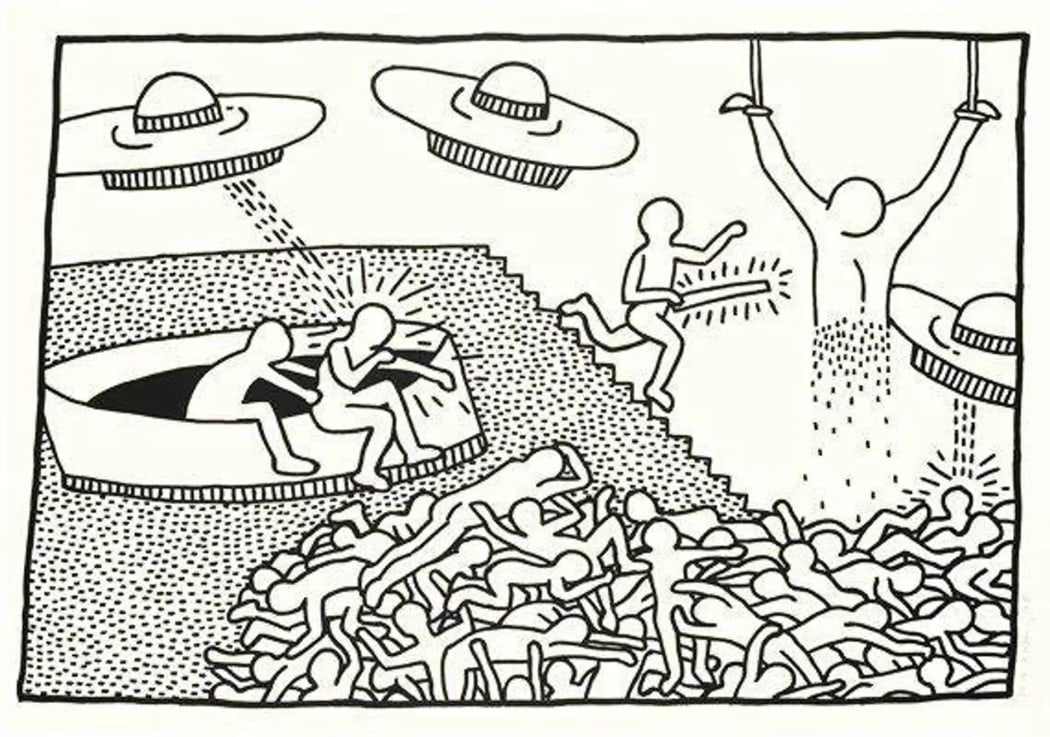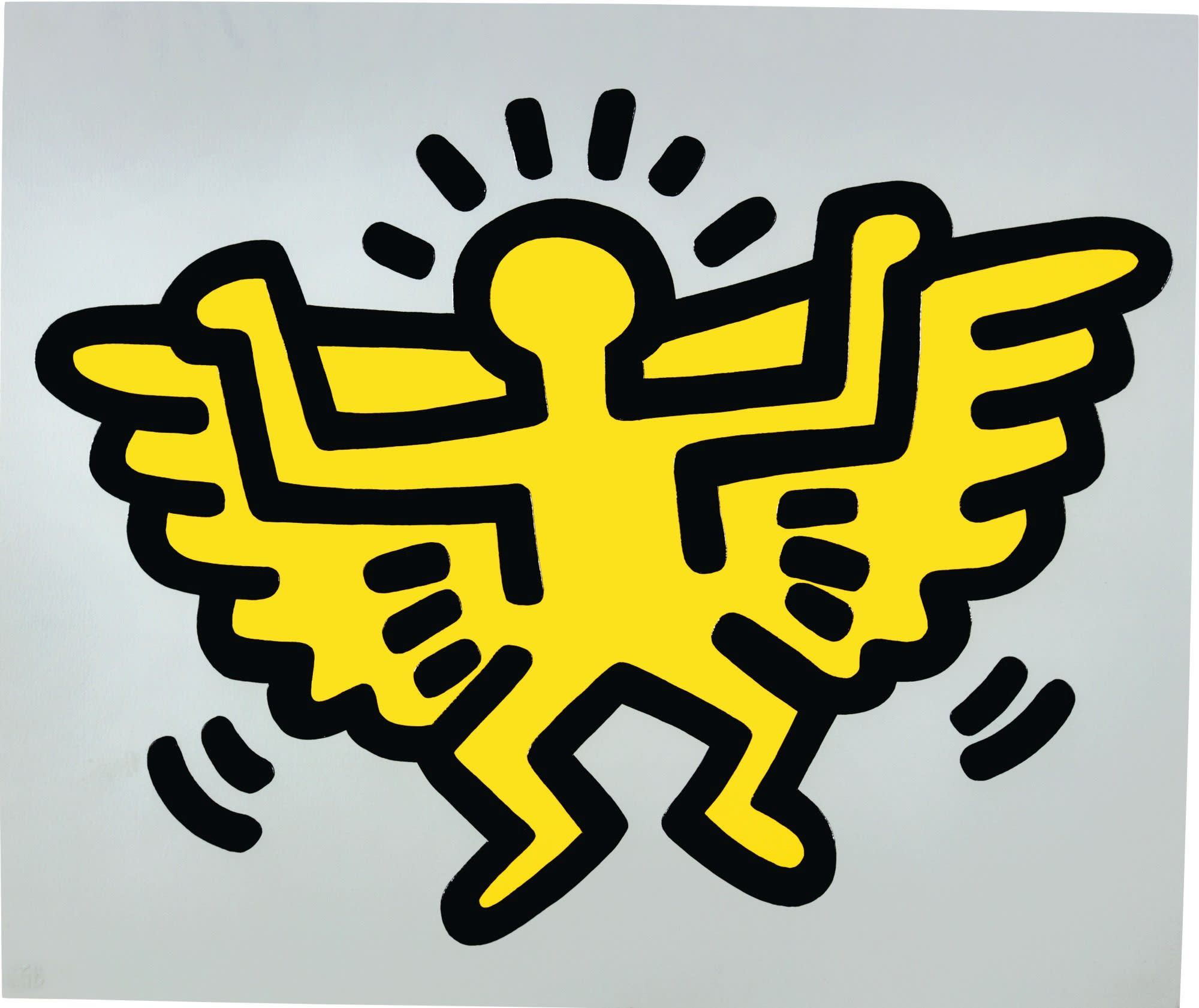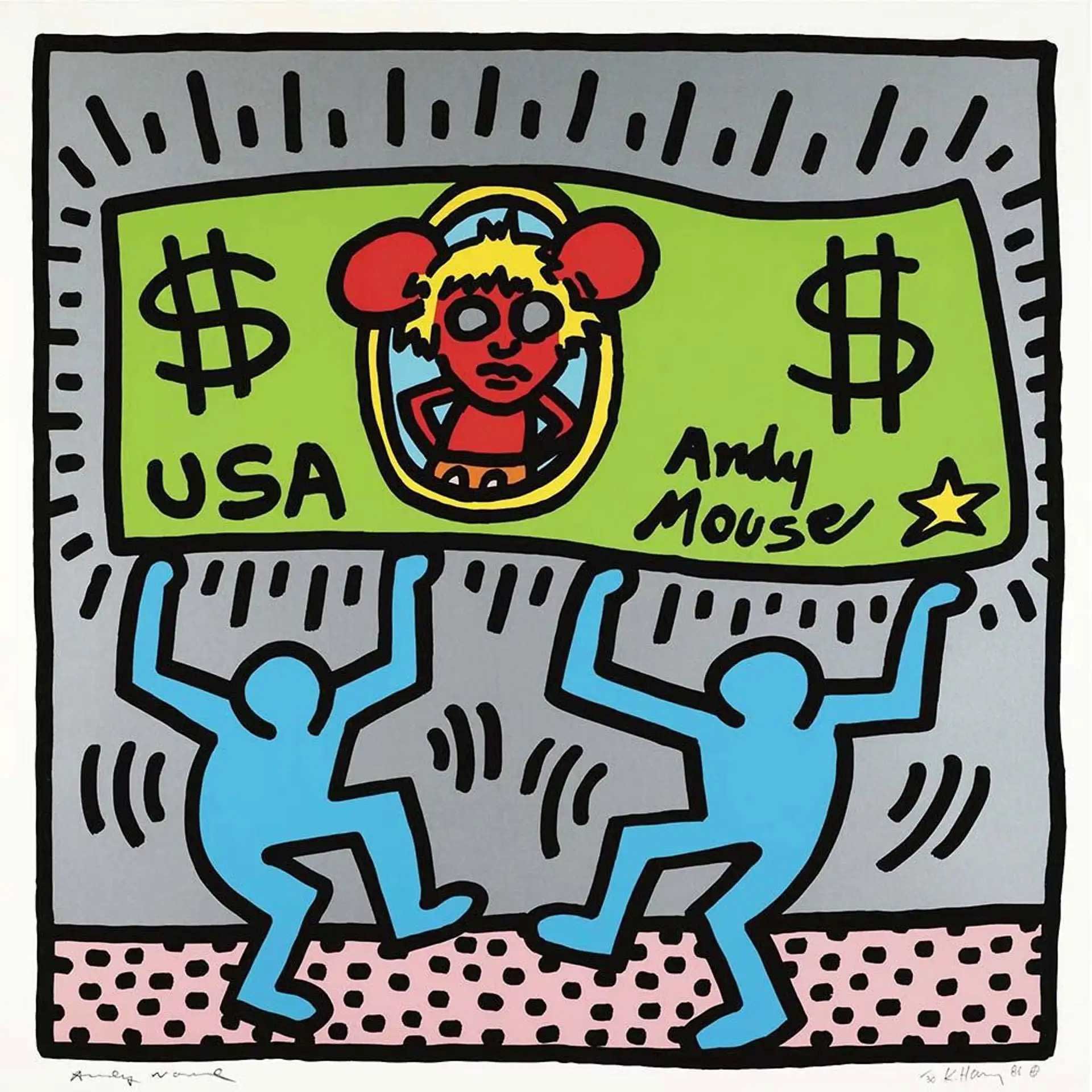
Keith Haring was a visionary armed with a marker and a boundless imagination. Born on May 4, 1958, in Reading, Pennsylvania, he was an American artist and activist whose work resonated with the cultural and political zeitgeist of his era.
Although he initially pursued a career as a commercial artist in Pittsburgh, it was in the vibrant tapestry of New York City that Keith Haring truly found his artistic home. His graffiti-inspired creations first captivated the public's eye within the New York City subway system. His chalk drawings on unused black advertising spaces swiftly evolved into a city-wide phenomenon, etching the name Keith Haring into the collective consciousness.
Art for All
Keith Haring firmly believed that art should be accessible to everyone, transcending barriers of wealth or education. This conviction propelled him to adorn public spaces, hospitals, orphanages, and schools with his mural masterpieces.
Activist at Heart
Haring's art often conveyed potent social messages. He openly embraced his identity as a gay man and took an active role in raising awareness about AIDS, a disease that would tragically claim his life in 1990.
Pop Shop
In 1986, Haring introduced the Pop Shop in New York City, an establishment where he peddled merchandise such as t-shirts and posters featuring his artwork. This venture further democratised his art, making it accessible to a broader audience.. Explore Pop Shop I for sale.

Collaborations
Keith Haring frequently collaborated with other artists and performers, including the iconic pop sensation Madonna and fellow artist Jean-Michel Basquiat.
Keith Haring's life may have been brief, but his influence on the art world and society at large was profound. His creations continue to inspire, provoke contemplation, and infuse joy into the hearts of people worldwide.
The Life Journey of Keith Haring
Keith Haring's life was an odyssey of creativity, activism, and a refusal to conform. Born into a middle-class family, his passion for art was ignited at an early age, with his father, an engineer and amateur cartoonist, serving as the catalyst for his love of drawing. However, it was not until he relocated to New York City that his distinctive artistic style began to crystallise.
In 1978, Haring made the momentous decision to move to New York City to study at the School of Visual Arts. The bustling cityscape became his canvas, as he used public spaces to disseminate his art to people from all walks of life, regardless of their social status or art expertise. His initial foray into public art consisted of chalk drawings on the black canvases of subway advertising spaces, a collection he aptly named "Subway Drawings."
As time progressed, Keith Haring emerged as a prominent figure within the East Village art scene in New York City, alongside his friend and fellow artist Jean-Michel Basquiat. He mingled with pop culture luminaries like Madonna and Andy Warhol, yet he steadfastly retained his belief that "Art is for everyone."
While making waves in the art world, Haring simultaneously used his art as a megaphone for societal issues. His creations served as a form of protest against racism, violence, and the ignorance surrounding the AIDS epidemic, which ravaged lives throughout the 1980s, ultimately claiming his own.
Although Keith Haring's life was tragically cut short at the tender age of 31, he lived his life in vivid hues, and his effervescent personality radiated through his artwork. His life stands as a reminder that art possesses the potential to effect change and should be accessible and enjoyable for all.
The Artistry of Keith Haring
Keith Haring's art is instantly recognizable, characterised by its bold lines, vibrant colours, and dynamic figures. His work exudes vitality, motion, and vitality—a true reflection of the dynamic streets and diverse cultures of New York City.
A defining element of Haring's art is his incorporation of symbols. He crafted his unique visual lexicon, replete with dancing figures, barking dogs, flying saucers, radiant babies, and television sets. Each symbol bore its distinct significance, and Haring employed them to convey messages regarding love, death, war, and society.
For instance, the 'radiant baby' symbol, among his most renowned, symbolises the purity and potential inherent in youth, while the 'barking dog' serves as a representation of authority and oppression. His art transcended mere aesthetics; it constituted a form of communication that resonated with individuals from all walks of life.

Another hallmark of Keith Haring's art is its accessibility. He firmly believed that art should be within reach of everyone, not confined to the elite spaces of galleries and museums. His 'Subway Drawings' epitomised this belief. Using chalk on black paper, he adorned subway stations, capturing the attention of thousands of daily commuters.
Keith Haring's art attests to his unwavering faith in the power of creativity to effect change. His oeuvre is not solely visually captivating but is also imbued with social commentary and messages of love and unity. His art functions as a vibrant visual diary of his life and the world he inhabited.
Iconic Artworks & Motifs
Keith Haring bequeathed a treasure trove of iconic artworks that continue to resonate with audiences today. Here's a brief tour of some of his most enduring pieces:
Radiant Baby
Arguably Keith Haring's most celebrated icon, the Radiant Baby depicts a crawling infant enveloped by lines of light. It symbolises hope and the promise of the future. Explore the Icons portfolio for sale at Andipa Editions.
Crack is Wack
Painted on a handball court in New York City, this mural serves as a stark commentary on the crack cocaine epidemic that gripped the city in the 1980s. Its message is unequivocal and direct, mirroring Haring's commitment to social activism.
Dancing Figures
Keith Haring's Dancing Figures represent some of his most joyful and recognizable symbols. The dynamic, interconnected figures signify unity, movement, and the ceaseless rhythm of life. Fertility Suite is a prime example of Harin’s energetic symbols.
Untitled (Subway Drawing)
This is where Keith Haring first made his indelible mark. Using white chalk on the black paper that concealed expired advertisements, Haring transformed subway stations into galleries of his signature figures and radiant babies. These ephemeral pieces were witnessed by thousands of daily commuters and helped solidify Haring's reputation as a trailblazing artist.
Each of these iconic artworks captures the spirit and vitality inherent in Keith Haring's art. They mirror his distinct style, his dedication to societal concerns, and his conviction in the ability of art to inspire and catalyse change.
Artistic Style and Theme
Let's delve deeper into what distinguishes Keith Haring's work—his unique artistic style and recurring themes.
Artistic Style
Haring's artistic style is bold, dynamic, and unmistakably his own. He drew inspiration from a myriad of sources, including graffiti, pop art and even ancient Egyptian hieroglyphics. His work is characterised by its vivid colours, confident lines, and figures brimming with energy. Despite the simplicity of his drawings, they pulsate with vitality and movement, as if poised to dance off the canvas.
Themes
Equally striking as Haring's visual style are the themes he explored through his art. Haring believed that art should reflect the society in which it is born, and he harnessed his work to cast a spotlight on the pressing issues of his time. From the battle against AIDS (Silence = Death for example) to the demise of apartheid in South Africa, to the perils of nuclear war—no subject was too vast or daunting for Haring. His work stands as a testament to his conviction in the potential of art as a tool for transformation and social justice.
Though Keith Haring's life was tragically truncated, his art style and thematic explorations continue to resonate with contemporary audiences, underscoring the enduring relevance and potency of his creations.
Impact and Influence on the Art World
So, how did Keith Haring disrupt the art world? In more ways than one might imagine.
To begin, Haring revolutionised the conventional conception of art and who could create it. His journey commenced with drawings in the New York subways, transforming the city's dreary walls into vibrant murals. This endeavour transcended the notion of the world as his canvas—it was a declaration that art belongs to all, irrespective of access to opulent galleries.
Furthermore, Keith Haring's art wasn't merely aesthetically pleasing—it bore a message. His work addressed a spectrum of social and political concerns, spanning from racism and homophobia to the AIDS crisis. This wasn't always met with unanimous acclaim—some argued that art should remain apolitical. Nevertheless, Haring remained resolute. He believed that art possessed the capacity to change the world and was unafraid to demonstrate it.
Lastly, Haring's influence extended beyond his own creations. He served as a mentor to fellow artists and was a vocal advocate for children's literacy and education. He established the Keith Haring Foundation in 1989, with the mission of providing financial support and imagery to AIDS organisations and children's programs. This commitment to social activism and positive change embodies Haring's legacy, one that endures as a source of inspiration for artists and activists globally.
When discussing Keith Haring's influence on the art world, we're not merely contemplating his distinctive style or courageous themes. We're contemplating an entirely novel perspective on art—a legacy that continues to galvanise artists and activists on a global scale.
Keith Haring and the Realm of Pop Art
When Pop Art comes to mind, we often conjure images of luminaries such as Andy Warhol or Roy Lichtenstein. However, did you know that Keith Haring was also a significant contributor to this movement?
Pop Art emerged in the 1950s as a reaction to the gravity of Abstract Expressionism. It celebrated—and critiqued—the images and concepts of popular culture. Keith Haring, with his affinity for cartoons, graffiti, and street art, seamlessly integrated into this milieu.
Nevertheless, Haring did not merely mimic his surroundings. He employed Pop Art's visual language to address matters that held personal significance. For instance, his iconic "Radiant Baby" image—a minimalist outline of a baby illuminated by energetic lines—symbolised hope and purity in a world often marred by complexity and darkness.
While Haring's work undeniably adhered to the Pop Art paradigm, it also pushed its boundaries. He leveraged the movement's fascination with everyday images to explore deeper themes encompassing life, death, and social justice. In doing so, he expanded our comprehension of what Pop Art could encompass and accomplish.
So, the next time you encounter a piece of Pop Art, whether it's an Andy Warhol soup can or a Keith Haring dancing figure, remember: it's not solely a visually pleasing depiction. It's a snapshot of the world surrounding us and a conduit for artists like Keith Haring to articulate their truth.

The Enduring Legacy of Keith Haring
What defines the legacy of an artist? Is it the volume of artwork produced during their lifetime? Or perhaps the number of exhibitions, accolades, and awards garnered? For Keith Haring, his legacy transcends his art—it is about how he harnessed his artistry to transform the world.
Haring's art served as a voice for the voiceless, a beacon of hope in tumultuous times. He addressed formidable topics such as AIDS, racism, and political oppression, giving them faces and voices through his vibrant, dynamic drawings. He wielded his art as a platform to raise awareness, initiate dialogues, and instigate action.
However, Haring's legacy extends beyond his artistic creations. He fervently championed children's literacy and education. In 1989, he founded the Keith Haring Foundation, dedicated to providing funding and imagery to AIDS organisations and children's programs. This commitment to social activism and positive change epitomises Haring's legacy, one that persists as an inspiration to artists and activists around the world.
When reflecting on Keith Haring, remember this: he wasn't merely an artist—he was a force for good in the world. His legacy underscores the potential of art to make an impact, to speak out, and to inspire change. It is a lesson from which we can all draw inspiration.
Explore our Keith Haring signed prints for sale and, for more Haring content, our new Keith Haring print guide.
